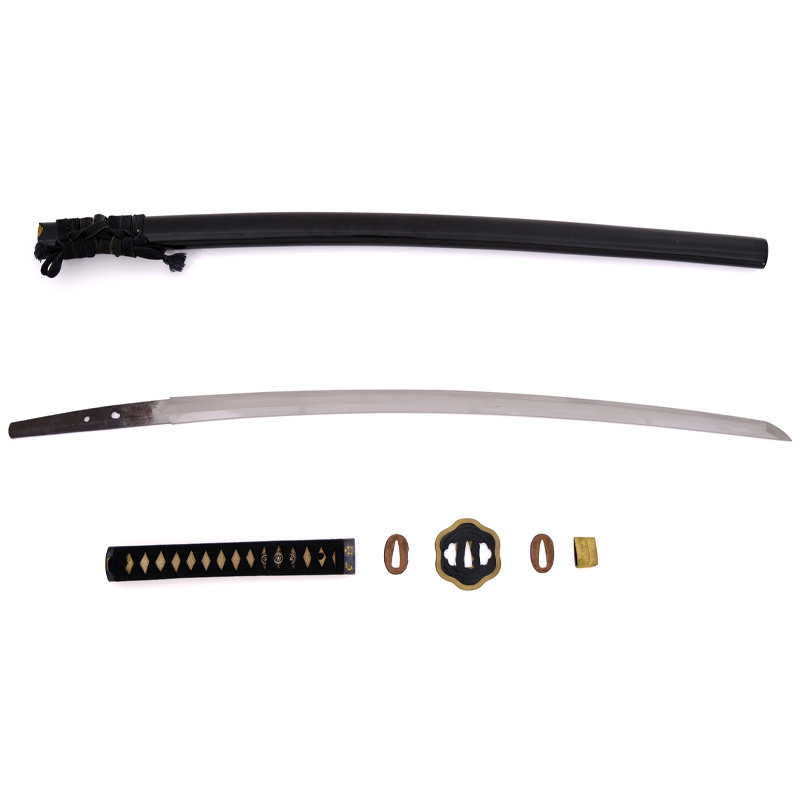













More informations about this product
| Total Weight | 1.296 kg | |
| Weight without Saya | 0.941 kg | |
| Blade Weight | 0.637 kg | |
| Full Blade length (Toshin) | 84.10 cm | |
| Nagasa | 66.8 cm | |
| Nakago Length | 17.3 cm | |
| Sori (curvature) | 2.10 cm | |
| Kissaki Length | 2.98 cm | |
| Moto Haba | 3.00 cm | |
| Saki Haba | 1.92 cm | |
| Moto Kasane | A = 0.62 cm B = 0.70 cm |
|
| Saki Kasane | A = 0.40 cm B = 0.42 cm |
|
| Curvature | Koshi Zori (Curvature on the first third) | |
| Type Kissaki | Elongated Chū Kissaki | |
| Blade Structure | Shinogi zukuri (diamond shape) | |
| Mune | Iori mune (Triangular) | |
| Hamon | Hotsure Suguha in Nioideki with Ko nie, Presence Nijuba, Uchinoke | |
| Hada | Itame-Mokume | |
| Boshi | Ko Maru Midare Kaeri (back on the Mune) | |
| Nakago | Mumei (unsigned), Suriage O Machi Okuri (shortened), 3 mekugi ana 2 being jointed (Hyotan Mekugi Ana), Futsugata Shape (classical), Kiri Yasurime (horizontal), Nakago Jiri Kurijiri (rounded) | |
| Saya | Length 79.3cm weight 354g, Saya lacquered Kuroro (glossy black), Sageo black silk, Koiguchi reinforced with brass ring | |
| Tsuka & Tosogu (Tsuba, Menuki, Fuchi Kashira) |
- Tsuka: Length 25.7cm, weight 134g, Tsuka with braiding Tsumami maki in black silk, Whole Same white, Menuki gilded with the motif of 3 ‘Dharma wheels’ (also called ‘Wheel of the Law’) 8 radius symbolizing the ‘Noble Eightfold Path’ of the middle leading to Nirvana, Fuchi Kashira in black patinated copper with gilded pattern of symbols and Archaic Kanji called ‘Kodaimoji’ 古 代 文 字 and used for divinatory purposes during the Bronze Period (3300 to 1200 BC). - Tsuba: Dimensions 7.6x6.95x0.5cm, weight 124g, Tsuba Muji (Without pattern), with 2 Kogai Ana, black center with golden border, Rokkaku-type general shape (Hexagon) symbolizing the 6 perfections (Paramitas) advised by Buddha (Generosity, Self-discipline, Patience, Perseverance, Concentration, Wisdom). - Habaki: Weight 20g, Habaki in gold leather, double habaki, Nekogaki oblique - Seppa: Two copper Seppa (2x9g) |
|
| Study & Team Review |
The origin of the Tegai 手掻 school dates back to the Kamakura period (1185–1333). The Tegai School is one of the 5 schools of the Yamato Den 大和, located opposite the Tengai Mon, the western gate of the Todaiji Temple in Nara. The founder of this Tegai lineage is Kanenaga 包永, a blacksmith of the late 13th century, many blacksmiths of this school inherited kanji ’Kane‘ in this form. |
|
Share your opinion
error Your review appreciation cannot be sent
feedback Report comment
check_circle Report sent
error Your report cannot be sent